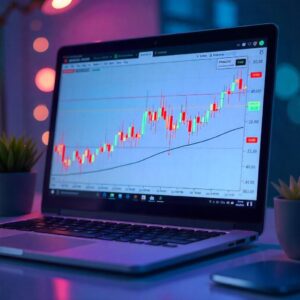Introduction to Forex Trading
Table of Contents
ToggleForex trading, also known as foreign exchange trading, is the process of exchanging one currency for another in the global financial market. It is one of the largest and most liquid markets in the world, with a daily trading volume exceeding $6 trillion. This market operates 24 hours a day, five days a week, allowing traders to participate at any time.

Key Terminology
Before diving into the intricacies of forex trading, it’s essential to understand some key terminology:
- Currency Pair: In forex trading, currencies are traded in pairs, such as EUR/USD (Euro/US Dollar) or GBP/JPY (British Pound/Japanese Yen).
- Pips: A pip is the smallest price movement in a currency pair. It is typically the fourth decimal place in most currency pairs.
- Leverage: Leverage allows traders to control a more extensive position with a smaller amount of capital. For example, a leverage of 100:1 means that for every $1, a trader can control $100.
- Spread: The spread is the difference between the bid price (the price at which you can sell) and the ask price (the price at which you can buy).
Understanding the Forex Market
The forex market is decentralized, meaning there is no central exchange. Instead, it operates through a network of banks, brokers, and financial institutions. The market is divided into several segments:
- Interbank Market: This is where large banks trade currencies among themselves. It is the most significant part of the forex market, accounting for a substantial portion of daily trading volume.
- Retail Market: Retail traders, or individual investors, access the forex market through brokers. They typically trade smaller amounts compared to institutional traders.
- Over-the-Counter (OTC): Most forex trading occurs over-the-counter, meaning transactions are conducted directly between parties rather than through an exchange.

Major Currency Pairs
Forex trading primarily involves major currency pairs, which include:
- EUR/USD: Euro/US Dollar
- USD/JPY: US Dollar/Japanese Yen
- GBP/USD: British Pound/US Dollar
- USD/CHF: US Dollar/Swiss Franc
These pairs are known for their liquidity and volatility, making them popular among traders.
Minor and Exotic Currency Pairs
In addition to major pairs, there are also minor and exotic currency pairs. Minor pairs do not involve the US Dollar and include currencies like the Australian Dollar (AUD), New Zealand Dollar (NZD), and Canadian Dollar (CAD). Exotic pairs involve a major currency and a currency from a developing economy, such as USD/TRY (US Dollar/Turkish Lira) or EUR/THB (Euro/Thai Baht). Exotic pairs tend to have lower liquidity and higher spreads, making them riskier to trade.
How Forex Trading Works
Forex trading involves buying one currency while simultaneously selling another. The goal is to profit from changes in exchange rates. For example, if a trader believes that the Euro will strengthen against the US Dollar, they might buy the EUR/USD pair. If the exchange rate increases, the trader can sell the pair for a profit.
Steps to Start Trading Forex
- Choose a Reliable Broker: Selecting a reputable forex broker is crucial. Look for a broker that is regulated and offers a user-friendly trading platform. Check reviews and compare spreads, fees, and available trading tools.
- Open a Trading Account: After choosing a broker, you need to open a trading account. Most brokers offer different account types, including demo accounts for practice. A demo account allows traders to practice trading without risking real money.
- Fund Your Account: Deposit funds into your trading account. Be mindful of the broker’s minimum deposit requirements and available funding methods.
- Develop a Trading Strategy: A solid trading strategy helps you make informed decisions. Consider factors such as technical analysis, fundamental analysis, and risk management. Create a plan detailing your entry and exit points, risk-reward ratio, and position size.
- Start Trading: Once you have a strategy in place, you can begin trading. Monitor the market closely and adjust your strategy as needed. Keep an eye on economic news and events that may impact currency prices.

Technical Analysis in Forex Trading
Technical analysis involves analyzing historical price data to predict future price movements. Traders use various tools and indicators to make informed decisions.
Key Technical Indicators
- Moving Averages: Moving averages smooth out price data to identify trends. Common types include the Simple Moving Average (SMA) and the Exponential Moving Average (EMA). The crossover of different moving averages can signal potential buy or sell opportunities.
- Relative Strength Index (RSI): The RSI measures the speed and change of price movements. It ranges from 0 to 100 and is used to identify overbought or oversold conditions. An RSI above 70 indicates that a currency pair may be overbought, while an RSI below 30 suggests it may be oversold.
- Bollinger Bands: Bollinger Bands consist of a middle band (SMA) and two outer bands that represent volatility. They help traders identify potential reversal points and breakouts. When the price approaches the upper band, it may indicate overbought conditions, while the lower band may signal oversold conditions.
- Fibonacci Retracement: This tool uses horizontal lines to indicate potential support and resistance levels based on the Fibonacci sequence. Traders often use Fibonacci retracement levels to identify entry and exit points in the market.
- MACD (Moving Average Convergence Divergence): The MACD is a trend-following momentum indicator that shows the relationship between two moving averages of a currency pair’s price. Traders look for crossovers between the MACD line and the signal line as potential buy or sell signals.

Fundamental Analysis in Forex Trading
Fundamental analysis involves evaluating economic indicators, news events, and geopolitical factors that can affect currency values. Understanding the underlying economic factors driving currency movements is essential for traders.
Key Economic Indicators
- Gross Domestic Product (GDP): GDP measures a country’s economic performance. A strong GDP growth rate can lead to currency appreciation, while a declining GDP may result in depreciation. Traders often look for GDP reports released quarterly.
- Interest Rates: Central banks set interest rates, which can significantly impact currency values. Higher interest rates typically attract foreign investment, leading to currency appreciation. Traders monitor central bank meetings and announcements for changes in monetary policy.
- Inflation Data: Inflation affects purchasing power and can influence central bank policies. Traders monitor inflation rates closely, as rising inflation may prompt central banks to raise interest rates.
- Employment Reports: Employment data, such as the Non-Farm Payroll (NFP) report in the US, can impact market sentiment and currency values. A strong jobs report may indicate economic strength, while a weak report may raise concerns about economic growth.
- Political Stability: Political events, elections, and government policies can affect currency values. Traders must stay informed about geopolitical developments and their potential impact on the forex market.
The Economic Calendar
Traders often use an economic calendar to stay updated on upcoming economic releases and events. The economic calendar highlights key reports, their release times, and their anticipated impact on the market. This tool helps traders prepare for potential market volatility and make informed trading decisions.
Risk Management in Forex Trading
Risk management is crucial for long-term success in forex trading. Traders should implement strategies to protect their capital and minimize losses.
Key Risk Management Strategies
- Set Stop-Loss Orders: A stop-loss order automatically closes a position when it reaches a predetermined price. This helps limit potential losses and protects your trading capital. For example, if you buy a currency pair at 1.2000, you might set a stop-loss at 1.1950 to limit your loss to 50 pips.
- Position Sizing: Determine the appropriate position size based on your account balance and risk tolerance. Avoid risking more than a small percentage of your capital on a single trade. A common rule is to risk no more than 1-2% of your account balance on any individual trade.
- Diversification: Diversifying your trading portfolio can help spread risk across different currency pairs and reduce the impact of adverse market movements. Consider trading a mix of major, minor, and exotic pairs to balance your exposure.
- Use Leverage Wisely: While leverage can amplify profits, it can also magnify losses. Use leverage cautiously and understand the risks involved. A high leverage ratio may seem appealing, but it can lead to significant losses if the market moves against your position.
- Regularly Review and Adjust: Continuously monitor your trades and overall trading performance. Regularly review your trading strategy and make adjustments based on your experiences and market changes.
Trading Psychology
Trading psychology plays a significant role in forex trading success. Emotions such as fear and greed can lead to impulsive decisions and poor trading outcomes.
Tips for Managing Trading Psychology
- Stick to Your Plan: Develop a trading plan and adhere to it. Avoid making impulsive decisions based on emotions. A well-defined plan outlines your trading goals, strategies, and risk management techniques.
- Stay Disciplined: Discipline is crucial for successful trading. Follow your strategy and resist the urge to deviate from it. Establish a routine that helps you maintain focus and discipline.
- Keep a Trading Journal: Document your trades, including your thought process and emotions. This can help you identify patterns and improve your trading skills. A trading journal allows you to reflect on your decisions and learn from both successes and failures.
- Take Breaks: If you feel overwhelmed or stressed, take a break from trading. Clear your mind before making any decisions. Stepping away from the screen can help you regain perspective and make more rational choices.
- Practice Mindfulness: Mindfulness techniques, such as meditation or deep breathing exercises, can help you manage stress and maintain a calm mindset while trading. Staying composed can lead to better decision-making.
Developing a Trading Strategy
A well-defined trading strategy is essential for success in forex trading. It should encompass your analysis methods, entry and exit points, risk management techniques, and trading goals.
Components of a Trading Strategy
- Market Analysis: Decide whether you will rely on technical analysis, fundamental analysis, or a combination of both. Each method has its strengths, and understanding how to apply them can enhance your trading decisions.
- Entry and Exit Points: Define the criteria for entering and exiting trades. Consider factors such as price action, support and resistance levels, and the use of technical indicators.
- Risk Management: Incorporate risk management techniques into your strategy. Determine your risk-reward ratio for each trade and set stop-loss orders to protect your capital.
- Timeframe: Decide on the timeframe you will trade. Forex traders can choose from various timeframes, including scalping (short-term), day trading, or swing trading (longer-term). Your choice will influence your trading style and strategy.
- Backtesting: Test your trading strategy on historical data to evaluate its effectiveness. Backtesting allows you to identify potential weaknesses and refine your approach before risking real money.

Types of Forex Trading Strategies
There are various trading strategies that traders employ based on their goals, risk tolerance, and market conditions. Here are a few popular strategies:
- Scalping: Scalping involves making multiple trades throughout the day to profit from small price movements. Scalpers aim to capture quick gains and typically hold positions for a few seconds to minutes.
- Day Trading: Day traders open and close positions within the same trading day, avoiding overnight exposure. They rely on short-term price movements and often use technical analysis to make quick decisions.
- Swing Trading: Swing traders hold positions for several days or weeks, aiming to profit from price swings. This strategy requires a moderate amount of time and analysis, allowing traders to capture larger price movements.
- Position Trading: Position traders take a long-term approach, holding positions for weeks, months, or even years. This strategy relies on fundamental analysis and macroeconomic trends.
- Trend Following: Trend-following strategies involve identifying and trading in the direction of prevailing market trends. Traders use technical indicators to confirm trends and set entry and exit points.
The Role of Technology in Forex Trading
Technology has significantly transformed forex trading, making it more accessible and efficient. Here are some key technological advancements:
- Trading Platforms: Modern trading platforms provide traders with advanced tools for analysis, charting, and order execution. Popular platforms like MetaTrader 4 (MT4) and MetaTrader 5 (MT5) offer a user-friendly interface and a wide range of features.
- Algorithmic Trading: Algorithmic trading involves using computer algorithms to execute trades based on predefined criteria. This method allows for faster execution and can help traders capitalize on market opportunities.
- Mobile Trading Apps: Mobile trading apps enable traders to access the forex market from their smartphones or tablets. This flexibility allows traders to monitor their positions and execute trades on the go.
- Social Trading: Social trading platforms allow traders to share their strategies and performance with others. Copy trading features enable less experienced traders to follow and replicate the trades of successful traders.
- Automated Trading Systems: Automated trading systems, also known as trading robots, execute trades on behalf of traders based on predefined rules. While these systems can save time, it’s essential to monitor their performance and adjust settings as needed.
Conclusion
Forex trading offers numerous opportunities for profit, but it also comes with risks. By understanding the market, developing a solid trading strategy, and implementing effective risk management techniques, traders can enhance their chances of success. Whether you’re a beginner or an experienced trader, continuous learning and adaptation are key to thriving in the dynamic world of forex trading.
Final Thoughts
As you embark on your forex trading journey, remember to stay informed about market trends, economic indicators, and trading strategies. Develop a comprehensive trading plan that aligns with your goals and risk tolerance. With dedication and practice, you can navigate the complexities of the forex market and work towards achieving your trading goals.
The key to success lies in your ability to adapt to changing market conditions, continuously refine your strategies, and manage your emotions effectively. As you gain experience, you will develop a deeper understanding of the market and become a more proficient trader. Always prioritize education and remain open to learning from both your successes and failures. Happy trading!


Pingback: A Comprehensive Guide To Stock Trading In 2025 - Info Spher Hub